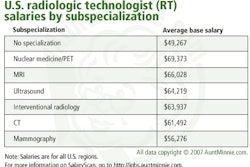
After looming large for two years, the Deficit Reduction Act (DRA) of 2005 finally took effect this past January. Now, six months into its implementation, U.S. outpatient imaging centers have a clearer sense of what they're up against.
The legislation has reduced outpatient imaging reimbursement for Medicare patients by capping the technical component for outpatient imaging to the lesser amount of either the Hospital Outpatient Prospective Payment System (HOPPS) or the Medicare Part B Physician Fee Schedule (MPFS). In addition, the Centers for Medicare and Medicaid Services (CMS) has implemented its technical portion reductions to outpatient diagnostic imaging for MR, CT, and ultrasound exams (on contiguous body parts performed in the same session).

"We're coordinating public relations and grassroots efforts to educate Congress on the impact of DRA."
-- Timothy Trysla, Access to Medical Imaging Coalition, Washington, DC
"We're coordinating public relations and grassroots efforts to educate Congress on the impact of DRA, not only to pass our bill, but also to make sure there are no additional cuts targeted at our industry," Trysla said. "When you look at the Medicare dataset that was used in the legislation, it points to an increase in the use of innovative diagnostic services. But it's not clear why. Is it because the technology has improved, or because there are new ways to diagnose disease, or because of self-referrals, or because doctors are practicing defensive medicine? There needs to be a more methodical approach to the data."
Just how bad is it?

"The profit margins that used to allow imaging center owners to make a decent living have disappeared."
-- Steve Renard, SR Consulting
Many centers expect their revenues to decline, according to a report published in May by market research firm IMV Medical Information Division of Des Plaines, IL. The report, "2007 Outlook for U.S. Diagnostic Imaging Centers: Strategies for Competing in the Post-DRA Era," includes data from 125 administrators from outpatient diagnostic imaging facilities across the U.S. More than three-quarters of the sample expect their annual revenues to decline in 2007 over 2006, according to Mary Patton, director of market research.
"Sixteen percent of our sample expects their revenue to decline by 25% or more -- the difference between profitability and unprofitability," she said.
The DRA has made many imaging center operators more conservative with capital equipment budgets, according to Bob Maier, president and CEO of Brentwood, TN-based Regents Health Resources, a healthcare consulting firm that provides services to hospitals and physician practices.
"Existing strong radiology or hospital group practices seem to be holding off on major capital investments or looking at acquiring refurbished machines until it's more clear what private payors are going to do," he said.

"Existing strong radiology or hospital group practices seem to be holding off on major capital investments."
-- Bob Maier, Regents Health Resources, Brentwood, TN
The IMV report, which breaks out revenue data by modality (and by field strength for MRI) confirms that MRI is the imaging modality expected to experience the greatest declines in revenues in 2007 versus previous years, Patton said.
Despite (or perhaps because of) the impending DRA cuts, imaging center chain RadNet of Los Angeles late last year bought Radiologix, a large imaging center chain, contributing to the industry's consolidation.
"We predicted that the DRA would create consolidation opportunities, and that has certainly come to pass," said Dr. Howard Berger, RadNet president and CEO. "We think this is healthy for the industry, and that consolidation will help prevent some of the overutilization we've been seeing."
Are procedures moving back into hospitals as a result of the legislation taking effect? It's unclear as of yet, but if it did, that would be disastrous, Berger said.
"Hopefully, with the consolidation some capacity will be eliminated and the business will stay in outpatient centers," he said. "Outpatient imaging is so much more cost-effective, not to mention a better experience for patients."
One pressing issue for many outpatient imaging center administrators is whether private payors plan to follow Medicare's example. Many large insurance companies haven't yet revealed their hand, according to Renard.
"Everyone is watching to see what commercial payors will do," Renard said. "Blue Cross has jumped on the DRA bandwagon with their HMO product, but other groups have been mute on the subject. It's ironic that the government's clamoring about overutilization, but if private payors follow Medicare's lead, it could create that very situation as centers try to push up volumes to counteract the cuts."
Even if they haven't come out with their own reductions, private payors are finding other ways to manage costs and utilization that end up squeezing imaging operators, Maier said.
"The impact overall on imaging centers has been more than they've expected it would be, and they're just starting to deal now with reductions from third-party payors who are trying to adjust to Medicare," he said. "Some of these private payors are making it tougher for doctors to refer patients at all by instituting preauthorization or requiring ACR accreditation requirements for the modalities the payors cover."

"We expect a $14 million impact on our retail business revenues and profitability as a result of the DRA. That's a lot of impact."
-- Paul Viviano, Alliance Imaging, Anaheim, CA
"We expect a $14 million impact on our retail business revenues and profitability as a result of the DRA," Viviano said. "That's a lot of impact."
Strategies for survival
Although the market has begun to consolidate and some facilities are closing, many centers have adopted tried-and-true management strategies in response to the DRA, evaluating the efficiency of business from every angle, and they began to use these strategies as soon as the DRA cuts were announced.
"We prepared for this. We didn't wait for it to happen," said Darlene Zase, executive director of Advanced Radiology Consultants (ARC), an independent radiology practice in Trumbull, CT. "We made plans to weather the storm by making sure we're running as efficiently as possible."
In addition to trying to increase procedure volumes by improving productivity and efficiency, ARC has outsourced its billing, renegotiated supply and maintenance contracts, and will try to negotiate with the one third-party payor that also reduced its reimbursement amounts. Zase stresses that these strategies are part of effective business management, with or without the DRA.
"The DRA reductions have made it even more critical that we run our business as efficiently as possible," Zase said. "The approaches we've used are just good business management -- we want to maintain our operations and increase growth without laying people off or reducing service or access."
Alliance Imaging's Viviano says his firm plans to focus completely on wholesale arrangements going forward, as well as operational efficiency. The company has also streamlined its staff, going from 10 operating regions to four.
"Roughly half of the financial impact of the DRA is from our mobile centers, so we're looking at how we can make driving routes and scheduling more efficient," he said.
ProScan Imaging of Cincinnati runs 26 freestanding centers across the U.S. that offer MR, nuclear medicine, CT, ultrasound, mammography, and PET; the company also provides reading service for more than 400 facilities. ProScan has not seen a change in its bottom line as of yet, according to CEO and medical director Dr. Stephen Pomeranz, but change is inevitable. In the post-DRA climate, ProScan is not planning to develop as many new facilities as it might have in the past, and is focusing on maintaining its existing equipment.
"There's no question that everyone's bottom line will go down unless they are successful at overcoming the reimbursement cuts -- if that's even possible," Pomeranz said. "Companies like ours are seeing, and will see, lower profits."
Another emerging trend is that, in the process of evaluating efficiency, outpatient centers are hiring a new breed of radiology administrator, according to Renard. "They're looking for people who can think strategically about how to protect their profits," he said. "It's a different style of manager than I've seen before, more entrepreneurial, more tactically minded. These new managers are going to conferences and marketing classes to understand how payor networking works and how effectively the center is billing."
The IT solution?
Centers will be taking a careful look at their IT structures in an effort to function more efficiently, finding ways to use their existing systems to decrease backlogs and improve workflow. Long overdue is the development of workflow "dashboards" that will allow a center to gauge its practices and retrieve benchmarking data, according to Renard.
"This kind of information is going to allow the new, savvy administrators to better manage the practice," he said. "One center can have a 1.5-tesla MR and be doing 18 scans per day, but at the other place down the road, the same magnet is doing 28. Benchmarking data will help centers figure out ways to be more efficient."
In any case, the DRA is pushing outpatient imaging centers to reevaluate how they work and seek the most efficient ways to offer quality patient care.
"It's a shakeout who survives this," Renard said. "Those who can weather the next few years by using good practice management and good research tools may end up catching the next wave."
By Kate Madden Yee
AuntMinnie.com staff writer
June 26, 2007
Disclosure notice: AuntMinnie.com is owned by IMV, Ltd.
Related Reading
Senators introduce DRA moratorium, May 10, 2007
Report: DRA causing centers to cut budgets, May 9, 2007
ARRS speaker: DRA may not be end of imaging payment cuts, May 7, 2007
Diagnostic radiology 2007 -- New year: BIG challenges, April 20, 2007
DRA's arrival forces imaging centers to adapt, February 1, 2007
Copyright © 2007 AuntMinnie.com



















